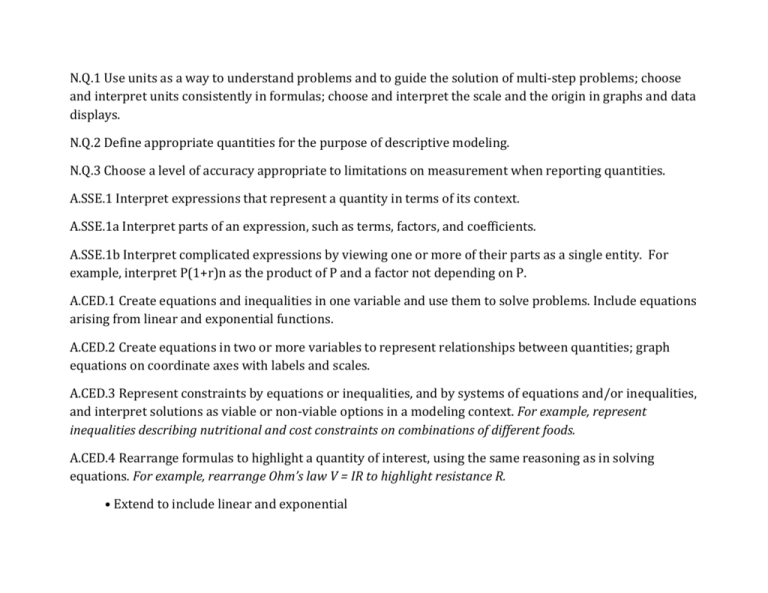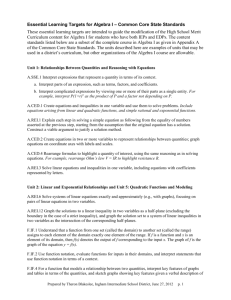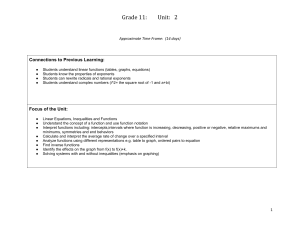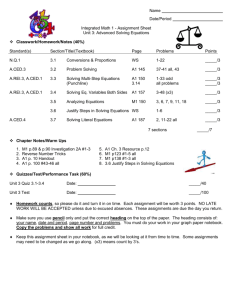Coordinate Algebra Standards
advertisement

N.Q.1 Use units as a way to understand problems and to guide the solution of multi‐step problems; choose and interpret units consistently in formulas; choose and interpret the scale and the origin in graphs and data displays. N.Q.2 Define appropriate quantities for the purpose of descriptive modeling. N.Q.3 Choose a level of accuracy appropriate to limitations on measurement when reporting quantities. A.SSE.1 Interpret expressions that represent a quantity in terms of its context. A.SSE.1a Interpret parts of an expression, such as terms, factors, and coefficients. A.SSE.1b Interpret complicated expressions by viewing one or more of their parts as a single entity. For example, interpret P(1+r)n as the product of P and a factor not depending on P. A.CED.1 Create equations and inequalities in one variable and use them to solve problems. Include equations arising from linear and exponential functions. A.CED.2 Create equations in two or more variables to represent relationships between quantities; graph equations on coordinate axes with labels and scales. A.CED.3 Represent constraints by equations or inequalities, and by systems of equations and/or inequalities, and interpret solutions as viable or non‐viable options in a modeling context. For example, represent inequalities describing nutritional and cost constraints on combinations of different foods. A.CED.4 Rearrange formulas to highlight a quantity of interest, using the same reasoning as in solving equations. For example, rearrange Ohm’s law V = IR to highlight resistance R. • Extend to include linear and exponential A.REI.1 Explain each step in solving a simple equation as following from the equality of numbers asserted at the previous step, starting from the assumption that the original equation has a solution. Construct a viable argument to justify a solution method. • Students should focus on and master linear equations and be able to extend and apply their reasoning to other types of equations in future courses A.REI.3 Solve linear equations and inequalities in one variable, including equations with coefficients represented by letters. • Extend earlier work with solving linear equations to solving linear inequalities in one variable and to solving literal equations that are linear in the variable being solved for. A.REI.5 Prove that, given a system of two equations in two variables, replacing one equation by the sum of that equation and a multiple of the other produces a system with the same solutions. A.REI.6 Solve systems of linear equations exactly and approximately (e.g., with graphs), focusing on pairs of linear equations in two variables. A.REI.10 Understand that the graph of an equation in two variables is the set of all its solutions plotted in the coordinate plane, often forming a curve (which could be a line). A.REI.11 Explain why the x‐coordinates of the points where the graphs of the equations y = f(x) and y = g(x) intersect are the solutions of the equation f(x) = g(x); find the solutions approximately, e.g., using technology to graph the functions, make tables of values, or find successive approximations. Include cases where f(x) and/or g(x) are linear and exponential. A.REI.12 Graph the solutions to a linear inequality in two variables as a half‐plane (excluding the boundary in the case of a strict inequality), and graph the solution set to a system of linear inequalities in two variables as the intersection of the corresponding half‐planes. F.IF.1 Understand that a function from one set (called the domain) to another set (called the range) assigns to each element of the domain exactly one element of the range. If f is a function and x is an element of its domain, then f(x) denotes the output of f corresponding to the input x. The graph of f is the graph of the equation y = f(x). F.IF.2 Use function notation, evaluate functions for inputs in their domains, and interpret statements that use function notation in terms of a context. F.IF.3 Recognize that sequences are functions, sometimes defined recursively, whose domain is a subset of the integers. For example, the Fibonacci sequence is defined recursively by f(0) = f(1) = 1, f(n+1) = f(n) + f(n‐1) for n ≥ 1 (n is greater than or equal to 1). F.IF.4 For a function that models a relationship between two quantities, interpret key features of graphs and tables in terms of the quantities, and sketch graphs showing key features given a verbal description of the relationship. Key features include: intercepts; intervals where the function is increasing, decreasing, positive, or negative; relative maximums and minimums; symmetries; end behavior; and periodicity. • Students should be able to interpret the intercepts; intervals where the function is increasing, decreasing, positive, or negative; and end behavior of exponential functions. • Compare and graph characteristics of a function represented in a variety of ways. Characteristics include domain, range, zeros, intercepts, extrema, points of discontinuity, intervals of increase and decrease, and rates of change. F.IF.5 Relate the domain of a function to its graph and, where applicable, to the quantitative relationship it describes. For example, if the function h(n) gives the number of person‐hours it takes to assemble n engines in a factory, then the positive integers would be an appropriate domain for the function. F.IF.6 Calculate and interpret the average rate of change of a function (presented symbolically or as a table) over a specified interval. Estimate the rate of change from a graph. F.IF.7 Graph functions expressed symbolically and show key features of the graph, by hand in simple cases and using technology for more complicated cases. F.IF.7a Graph linear functions and show intercepts, maxima, and minima. F.IF.7e Graph exponential functions, showing intercepts and end behavior. F.IF.9 Compare properties of two functions each represented in a different way (algebraically, graphically, numerically in tables, or by verbal descriptions). For example, given a graph of one quadratic function and an algebraic expression for another, say which has the larger maximum. F.BF.1 Write a function that describes a relationship between two quantities. .F.BF.1a Determine an explicit expression, a recursive process, or steps for calculation from a context. F.BF.1b Combine standard function types using arithmetic operations. For example, build a function that models the temperature of a cooling body by adding a constant function to a decaying exponential, and relate these functions to the model. F.BF.2 Write arithmetic and geometric sequences both recursively and with an explicit formula, use them to model situations, and translate between the two forms. F.BF.3 Identify the effect on the graph of replacing f(x) by f(x) + k, k f(x), f(kx), and f(x + k) for specific values of k (both positive and negative); find the values of k given the graphs. Experiment with cases and illustrate an explanation of the effects on the graph using technology. Include recognizing even and odd functions from their graphs and algebraic expressions for them. F.LE.1 Distinguish between situations that can be modeled with linear functions and with exponential functions. F.LE.1a Prove that linear functions grow by equal differences over equal intervals and that exponential functions grow by equal factors over equal intervals. F.LE.1b Recognize situations in which one quantity changes at a constant rate per unit interval relative to another. F.LE.1c Recognize situations in which a quantity grows or decays by a constant percent rate per unit interval relative to another. F.LE.2 Construct linear and exponential functions, including arithmetic and geometric sequences, given a graph, a description of a relationship, or two input-output pairs (include reading these from a table). F.LE.3 Observe using graphs and tables that a quantity increasing exponentially eventually exceeds a quantity increasing linearly. • Explore rates of change, comparing rates of change. F.LE.5 Interpret the parameters in a linear or exponential function in terms of a context. G.CO.1 Know precise definitions of angle, circle, perpendicular line, parallel line, and line segment, based on the undefined notions of point, line, distance along a line, and distance around a circular arc. G.CO.2 Represent transformations in the plane using, e.g., transparencies and geometry software; describe transformations as functions that take points in the plane as inputs and give other points as outputs. Compare transformations that preserve distance and angle to those that do not (e.g., translation versus horizontal stretch). G.CO.3 Given a rectangle, parallelogram, trapezoid, or regular polygon, describe the rotations and reflections that carry it onto itself. G.CO.4 Develop definitions of rotations, reflections, and translations in terms of angles, circles, perpendicular lines, parallel lines, and line segments. G.CO.5 Given a geometric figure and a rotation, reflection, or translation, draw the transformed figure using, e.g., graph paper, tracing paper, or geometry software. Specify a sequence of transformations that will carry a given figure onto another. G.GPE.4 Use coordinates to prove simple geometric theorems algebraically. For example, prove or disprove that a figure defined by four given points in the coordinate plane is a rectangle; prove or disprove that the point (1, √3) lies on the circle centered at the origin and containing the point (0, 2). G.GPE.5 Prove the slope criteria for parallel and perpendicular lines and use them to solve geometric problems (e.g., find the equation of a line parallel or perpendicular to a given line that passes through a given point). G.GPE.6 Find the point on a directed line segment between two given points that partitions the segment in a given ratio. G.GPE.7 Use coordinates to compute perimeters of polygons and areas of triangles and rectangles, e.g., using the distance formula. S.ID.1 Represent data with plots on the real number line (dot plots, histograms, and box plots). • Choose appropriate graphs to be consistent with numerical data: dot plots, histograms, and boxplots. S.ID.2 Use statistics appropriate to the shape of the data distribution to compare center (median, mean) and spread (interquartile range, standard deviation) of two or more different data sets. • Include review of Mean Absolute Deviation as a measure of variation S.ID.3 Interpret differences in shape, center, and spread in the context of the data sets, accounting for possible effects of extreme data points (outliers). • Students will examine graphical representations to determine if data are symmetric, skewed left, or skewed right and how the shape of the data affects descriptive statistics. S.ID.5 Summarize categorical data for two categories in two‐way frequency tables. Interpret relative frequencies in the context of the data (including joint, marginal, and conditional relative frequencies). Recognize possible associations and trends in the data. S.ID.6 Represent data on two quantitative variables on a scatter plot, and describe how the variables are related. S.ID.6a Fit a function to the data; use functions fitted to data to solve problems in the context of the data. Use given functions or choose a function suggested by the context. Emphasize linear, quadratic, and exponential models. S.ID.6b Informally assess the fit of a function by plotting and analyzing residuals. S.ID.6c Fit a linear function for a scatter plot that suggests a linear association. S.ID.7 Interpret the slope (rate of change) and the intercept (constant term) of a linear model in the context of the data. S.ID.8 Compute (using technology) and interpret the correlation coefficient of a linear fit. S.ID.9 Distinguish between correlation and causation.









